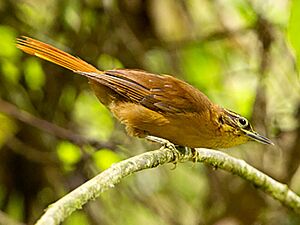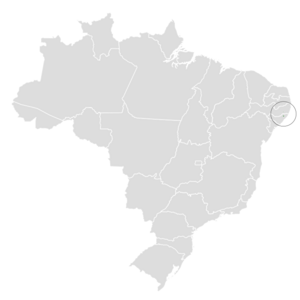Alagoas foliage-gleaner facts for kids
Quick facts for kids Alagoas foliage-gleaner |
|
|---|---|
 |
|
| Conservation status | |
| Scientific classification | |
| Genus: |
Philydor
|
| Species: |
novaesi
|
 |
|
The Alagoas foliage-gleaner (scientific name: Philydor novaesi) was a small passerine bird. It belonged to the ovenbird family, called Furnariidae. This bird was only found in Brazil, meaning it was endemic there. Sadly, the Alagoas foliage-gleaner is now extinct.
Contents
About the Alagoas Foliage-Gleaner
How it was Named
Scientists first found the Alagoas foliage-gleaner in 1979. This happened in a place called Murici, in the state of Alagoas, Brazil. They officially described it in 1983.
They named it Philydor novaesi. The second part of its name, novaesi, honors a Brazilian bird expert named Fernando da Costa Novaes. Scientists placed it in the Philydor group because of how it looked and acted. It was very similar to another bird, the black-capped foliage-gleaner.
When and Where it was Seen
The Alagoas foliage-gleaner was first discovered in 1979. All sightings happened in two main areas in Brazil. These were Murici in Alagoas and Frei Caneca in Pernambuco. Frei Caneca was about 50 km (31 mi) north of Murici.
Between 1979 and 2009, people saw the bird several times in Murici. Sometimes they saw one bird, and once they saw four together. In 2003, up to four birds were seen at Frei Caneca. People continued to see them there until 2011.
The very last time this bird was officially seen was on September 13, 2011. Someone recorded a video of it at Frei Caneca. There was one more possible sighting in April 2012, but it was not confirmed.
What Did it Look Like?
The Alagoas foliage-gleaner was about 19.3 to 20 cm (7.6 to 7.9 in) long. Males weighed about 32 to 34 grams (1.1 to 1.2 oz). Females were a bit lighter, around 30 grams (1.1 oz).
Both male and female birds looked the same. They had a light, pale buff ring around their eyes. A dark band went behind their eyes. Their crown, or the top of their head, was dark brown. Their back was a dull reddish-brown color. Their tail was a bright reddish-orange. Their wings were dark reddish-brown.
Their chin and throat were a dull reddish color. Their belly was also reddish. Their eyes were brown. Their beak was dark on top and ivory-colored underneath. Their legs and feet were greenish. Young birds were not described.
Where Did it Live?
The Alagoas foliage-gleaner was only known from Murici and Frei Caneca. These places had hilly tropical evergreen forest. They also had secondary forest, which is forest that has grown back after being cut down.
These forests were full of tangled vines, bromeliads, mosses, and orchids. The birds lived at elevations between 400 and 550 meters (1,300 and 1,800 ft) high.
Behavior of the Alagoas Foliage-Gleaner
How it Moved
As far as we know, the Alagoas foliage-gleaner did not migrate. It stayed in the same area all year round.
What it Ate
These birds often joined mixed-species foraging flocks. This means they would look for food with other types of birds. They ate adult insects and insect larvae.
They moved very actively and skillfully among branches and vines. They found their food by picking insects off live and dead leaves. They also looked on bark and in other plant bits. They would often pull apart bunches of dead leaves. Sometimes, they would even tap on branches with their beak to pull larvae out of dead wood. They looked for food at all levels of the forest, from the ground to the tops of the trees.
Breeding Habits
Scientists know very little about how the Alagoas foliage-gleaner reproduced. One young bird was found in January, but not much else is known.
What it Sounded Like
The song of the Alagoas foliage-gleaner was a "high-pitched rattle." It would get a little lower in sound and last for about 3 to 5 seconds. One of its calls sounded like "thürr," "thoor," or "theer." Another call was a descending "uüarrr, uüarr."
Why it Became Extinct
The IUCN (International Union for Conservation of Nature) first listed the Alagoas foliage-gleaner as Threatened in 1988. In 1994, its status changed to Critically Endangered. This means it was in extreme danger of disappearing.
Sadly, in 2019, the IUCN officially declared it Extinct as of 2011. Brazilian authorities had already declared it extinct in 2014. The main reason for its extinction was the loss of its home. The two places where it lived were small parts of the huge Atlantic Forest.
Most of the Atlantic Forest was cut down for wood, charcoal, and to make space for farms. What little forest was left faced threats from illegal logging and fires. Climate change also made things worse.
Images for kids




